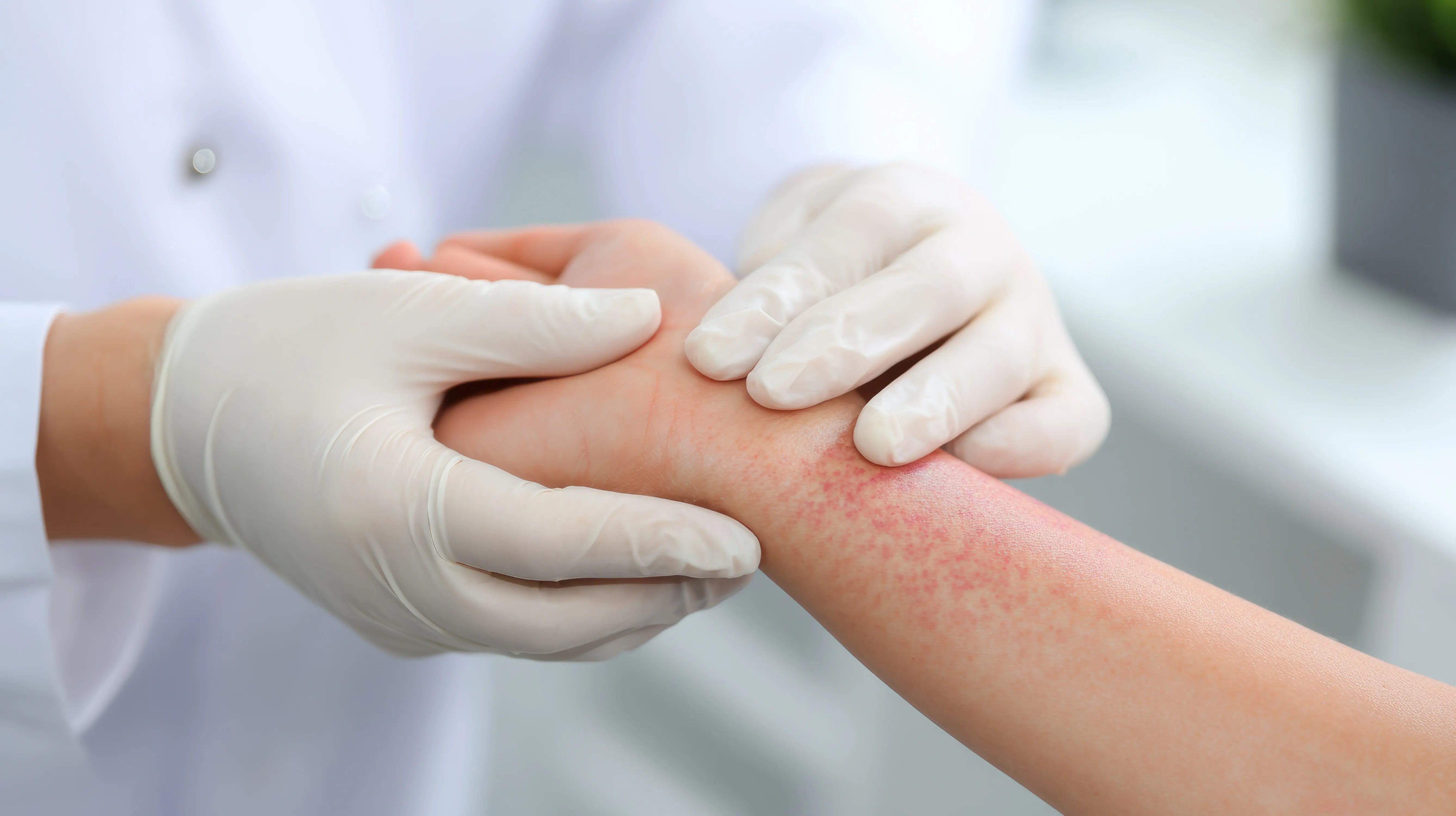Atopic eczema (or atopic dermatitis) is a chronic inflammatory skin condition, common in infants and young children. It affects approximately 10 to 20% of children and manifests through dry skin, redness, and intense itching. This non-contagious condition evolves through successive flare-ups interspersed with periods of remission. There is a family predisposition (allergic or atopic background) and an alteration of the skin barrier that make the skin more vulnerable. While atopic eczema cannot be "cured" definitively, it can be effectively controlled: many children see their condition improve as they grow, with symptoms disappearing during adolescence in most cases. In the meantime, appropriate management helps relieve the child and reduce the frequency of flare-ups.
Understanding Atopic Eczema
What is atopic eczema?
Atopic eczema is a chronic inflammation of the skin, linked to abnormalities in immunity and the skin barrier. It often begins in early childhood (sometimes from the first months of life) and manifests through red patches that itch intensely (pruritus), very dry skin (xerosis), and a tendency toward secondary infections. We talk about an "atopic background" because this dermatitis is often associated with other allergic manifestations (asthma, rhinitis, food allergies) in the child or their relatives.
Several factors promote atopic eczema: a genetic component (for example, filaggrin mutations that weaken the skin) and environmental factors (allergens, irritants, pollution, climate). Unlike contact eczema, atopic eczema is not triggered by a single allergen: the skin is generally hyper-reactive. The disease evolves through inflammatory flare-ups interspersed with remissions during which the skin remains very dry and sensitive.
Over time, atopic eczema tends to improve naturally. Lesions may disappear spontaneously within a few years in mild forms. However, more severe forms may persist into adolescence and adulthood. The good news is that with appropriate treatment and suitable daily care, symptoms can generally be controlled and the child can enjoy a satisfactory quality of life.
Characteristic symptoms by age
The manifestations of atopic eczema vary according to the child's age:
- Infant (under 2 years): Eczema often appears before 6 months of age. The first lesions are mainly located on the face (cheeks, forehead, chin) and on the outer surfaces of arms and legs. The skin is red, sometimes oozing then crusty. A baby has permanently very dry skin and may rub against sheets or carpet to relieve itching, which disrupts sleep. The scalp may also be affected. At this age, folds (elbow, knees) are generally spared.
- Child aged 2 to 11 years: After 2 years, eczema becomes more localized in flexural folds: inner elbows, behind knees, wrists, ankles, neck folds, sometimes eyelids. The skin is thickened by repeated scratching (lichenification) and remains very dry, especially in winter (cold and dry air worsen symptoms). The child scratches a lot, especially in the evening or at night, which can lead to scratch lesions and a risk of infection. Intense itching can make the child irritable or distracted during the day.
- Adolescent (12 years and older): In most cases, eczema improves during puberty. However, in some adolescents or young adults, chronic lesions persist. These are located in the same places as in children (folds, hands, feet) but may also more readily affect the face and neck, upper trunk, or hands. The skin remains very dry and sensitive to irritants. Adolescent eczema can be aesthetically troublesome and impact quality of life, hence the importance of good support.

Triggering factors to know
Many triggering or aggravating factors can cause an atopic eczema flare-up. These elements vary from one child to another, but it's important to know them to better avoid them:
- Irritants: anything that can irritate fragile skin can trigger a flare-up. For example, using aggressive or perfumed soaps, bubble baths, showers that are too hot, laundry detergents or household products containing powerful detergents, contact with wool or rough textiles, or cigarette smoke. Gentle, hypoallergenic products should be preferred, and the child should be dressed in soft cotton clothing.
- Allergens: although atopic eczema is not an allergy in the strict sense, environmental allergens can worsen it. The main ones are dust mites, pollen, pet hair (cat, dog), mold, and sometimes certain foods. In toddlers already allergic to a food (for example, egg or peanut), consuming that food may be accompanied by an eczema flare-up. It's recommended to check with an allergist if an associated allergy is suspected.
- Climate and environment: Temperature changes and heat exposure are often poorly tolerated by atopic skin. Excessive heat or very dry air (heating in winter) dry out the skin and promote itching. Conversely, harsh cold and wind can also irritate. Sweating is a common triggering factor: sweat, when evaporating, leaves irritating salty residues on the skin. Therefore, care must be taken not to overdress the child and to cool them down after sweating.
- Stress and emotions: Stress is never the initial cause of atopic eczema (which is an organic disease, not psychosomatic). However, it's observed that strong emotions, anxiety, or fatigue can worsen symptoms. For example, a child stressed by school or excited by an event may have a flare-up more easily. It's therefore helpful to teach the child relaxation techniques appropriate for their age.
Each child has their own eczema triggers. Parents will learn over time to identify the elements that precede flare-ups. Keeping a small flare-up diary can help: note events (food-related, environmental, emotional) from the 24-48 hours preceding a crisis to spot correlations and limit recurrences as much as possible.
Medical treatments for atopic eczema
When eczema is established, particularly during an acute flare-up phase, medical treatments are necessary to control inflammation and calm itching. The dermatologist or pediatrician adapts the treatment according to the severity of eczema, the child's age, and the affected areas.
Topical corticosteroids: first-line treatment
The basic treatment for atopic eczema in the inflammatory phase relies on topical corticosteroids, that is, cortisone-based creams or ointments for topical use. These topical corticosteroids are considered the first-line treatment during flare-ups. Applied directly to lesions, they quickly reduce skin inflammation and relieve redness and itching within a few days. They don't cure the disease permanently but effectively treat symptoms during flare-ups.
Topical corticosteroids come in several potencies (weak, moderate, strong, very strong) and in different vehicles (cream, ointment, lotion). The choice of molecule and form is made by the doctor based on the child's age, the area to be treated, and the skin's condition. For example, an ointment is preferred on a very dry patch, while a cream is better on an oozing lesion or in folds.
How to use them? In practice, the corticosteroid cream is applied once a day (preferably in the evening) to eczema patches, in a thin layer, until lesions disappear. It's important to treat all visible red areas and continue for a few days after symptoms disappear to properly extinguish deep inflammation. Once the flare-up is controlled, stop the corticosteroid and resume daily moisturizing with an emollient.
What about side effects? Topical cortisone application sometimes scares parents (corticophobia), but it's important to know that these treatments are very well tolerated in children if recommendations are followed. Side effects (skin thinning, growth delay) are extremely rare with modern topical corticosteroids, as the molecule acts mainly locally. The main risk, in fact, is underusing the cream due to unfounded fear: poorly treated eczema can worsen, become infected, and require heavier treatments. Therefore, don't hesitate to apply the prescribed corticosteroid treatment as soon as a flare-up starts.
Topical immunomodulators
Topical immunomodulators are supplementary anti-inflammatory treatments, without cortisone, used in atopic eczema when topical corticosteroids are not sufficient or not indicated. These are mainly tacrolimus ointment and pimecrolimus cream. These medications act on the skin's immune system to reduce inflammation. They are also applied to eczema lesions, generally twice daily initially, then possibly as maintenance (a few times per week) on problem areas to prevent relapses.
When are these creams used? They may be prescribed by the dermatologist in children over 2 years old with moderate to severe eczema, especially if eczema affects delicate areas where repeated cortisone use should be avoided (for example, the face, eyelids). Tacrolimus doesn't cause skin atrophy, making it useful for thin areas. It can also be used as a follow-up to corticosteroids, as twice-weekly maintenance, to space out frequent flare-ups. These treatments may cause some transient stinging upon application but are generally well tolerated long-term.
Systemic treatments for severe forms
In severe forms of atopic eczema – fortunately rare in children – or when topical treatments fail to control the disease, the doctor may consider systemic treatments. A systemic treatment means a treatment that acts generally throughout the body (orally or by injection), as opposed to topical creams. This type of management concerns a minority of patients but provides real relief for the most difficult cases:
- Phototherapy (PUVA, UVB): These are therapeutic ultraviolet light sessions performed at a dermatologist's office. UV rays have an anti-inflammatory effect and can significantly improve moderate to severe atopic eczema, particularly in adolescents or adults. Phototherapy is offered for limited durations (a few months maximum) to avoid a risk of premature aging or long-term skin cancer. This treatment is not used in very young children.
- Oral immunosuppressive medications: These are tablet treatments acting on the immune system. The best known is cyclosporine, which can be prescribed in adolescents over 16 years old with severe resistant eczema (under strict medical supervision as it requires biological monitoring). Other molecules like methotrexate are sometimes used off-label in children with treatment failure. These general treatments are reserved for severe cases due to their potential side effects.
- Biotherapies (new generation treatments): In recent years, new treatments targeting eczema mechanisms have appeared. The main one is dupilumab, an injectable monoclonal antibody that blocks molecules involved in eczema inflammation. This treatment has shown great efficacy in severe eczema in adults and children (it's authorized in children from 6 months old in the EU). Dupilumab is administered by subcutaneous injection every two weeks and often allows marked improvement in lesions and pruritus within a few months, with good long-term tolerance. Other biotherapies are being studied to expand the therapeutic arsenal for severe eczema.
It's reassuring to know that even for the most severe atopic eczema, medical solutions exist. Nevertheless, in the vast majority of childhood eczema cases, well-conducted topical treatments are sufficient to manage the disease. Regular use of corticosteroid creams during flare-ups, coupled with good daily skin care, prevents resorting to heavy treatments.
Complementary care to accompany treatment

The importance of daily moisturizing
Daily moisturizing is essential. Eczematous skin lacks lipids and water: applying a moisturizer helps restore the skin barrier, strengthen the skin, and keep flare-ups at bay.
Apply an emollient cream all over the body every day, at least once (ideally twice). The best time: just after washing on slightly damp skin. Every day without exception, even when everything is fine.
Emollients suitable for atopic skin
Use emollients specially formulated for atopic skin, rich in moisturizing and lipid-replenishing agents (glycerin, shea butter, vegetable oils, ceramides), without fragrance or irritating substances.
The French brand Doucéa offers APAISÉA cream for sensitive skin and DOUTOPIA cream for very dry and atopic-prone skin. These emollients contain a trio of natural oils (sweet almond, sunflower, jojoba), vitamin E, and inulin (prebiotic) to strengthen the skin flora.
Apply in sufficient quantity (a hazelnut-sized amount per area) until absorbed. Warm the cream between your hands before application.
The role of prebiotics in caring for weakened skin
Prebiotics nourish the good bacteria on the skin. The skin microbiome plays an important role: in atopic dermatitis, an imbalance is observed with proliferation of pathogenic bacteria. Prebiotics help support beneficial microbes and restore a healthy balance.
Doucéa products contain inulin and Lactobacillus ferment (probiotic) in the micellar water to preserve the skin ecosystem. This promising area complements the action of classic emollients.
Preventing eczema flare-ups daily
Adopting a gentle hygiene routine
- Bath or shower: Lukewarm water (95°F), limited duration (5-10 minutes), without bubble bath or perfumed essential oils.
- Suitable soap: Soap-free dermatological bar (syndet) or ultra-gentle cleansing gel, fragrance-free, special for atopic skin.
- Drying: Pat with a soft towel without rubbing, leave skin slightly damp to better absorb cream.
- Micellar water: For face cleansing or diaper changes, use a special baby/sensitive skin micellar water. Doucéa Micellar Water contains organic chamomile and cornflower floral waters for soothing, coupled with prebiotics and probiotic to strengthen the skin barrier. Ideal, no-rinse to avoid any contact with tap water which can be somewhat "hard".
Identifying and avoiding aggravating factors
- Clothing: Soft and breathable materials (cotton, bamboo). Avoid wool and occlusive synthetics. Remove labels. Hypoallergenic detergent without perfumed fabric softener.
- Household allergens: Anti-mite bedroom (covers, bedding washed at 140°F), daily ventilation, limit carpets and rugs. If pets: prohibit access to the bedroom. During pollen season: close windows in the morning, rinse hair in the evening.
- Diet: No food prohibited without medical advice. If allergy diagnosed, strict exclusion. Balanced diet rich in essential fatty acids.
Adapting the child's environment
- Temperature and humidity: Maintain 66-68°F, use a humidifier in winter if air is dry (50% humidity ideal).
- Bedding and sleep: Cotton or linen sheets, don't over-cover. Short and filed nails. Cotton over-pajamas or gloves at night if necessary.
- Indoor products: Reduce air freshener sprays, incense, scented candles. No secondhand smoke.
- Daycare/school: Inform caregivers, provide a kit (emollient cream, cotton gloves, spare T-shirt).
Supporting your child daily with atopic eczema
Managing itching and scratching
- Short nails and clean hands. Cotton mittens for toddlers at night.
- Cold as an ally: Cool washcloth, refrigerated gel pack, thermal water spray kept in the fridge.
- Diversion technique: Offer immediate distraction (game, massage, nursery rhyme). Special scratching toy or stress ball.
- Soothing moisturizer: Apply emollient cream as soon as itching occurs.
- Antihistamine: By medical prescription if nights are very disrupted.
Eczema and activities: sports, swimming, sun
- Sports: Breathable clothing, lukewarm shower after exercise, generous body moisturizing.
- Pool: Apply barrier cream before swimming, rinse thoroughly after, moisturize immediately.
- Sea: Rinse with fresh water after swimming, remove sand regularly.
- Sun: High tolerance SPF 50+ sunscreen, reapply every 2 hours. UV-protective shirt and hat. Avoid exposure 12pm-4pm.
Emotional support for the child
- Dialogue and explain: Remove child's guilt, show it's common (1 in 5 children). Explain with words appropriate for their age.
- Don't dramatize: Reassuring and positive discourse. Prepare phrases to answer curious friends.
- Involve the child: Make them an actor in their treatment (apply cream themselves). Reward chart. Doucéa's playful cases (For Dreaming, For Exploring, For Discovering) transform product application into playtime.
- Reinforce self-esteem: Value the child for all their qualities beyond their skin. Contact patient associations if needed.

With patience, kindness, and the right information, you'll help your child overcome the challenges related to eczema. Most of the time, eczema improves as they grow: what you teach them today will serve them throughout their life.
















